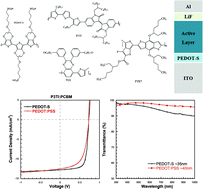Self-doped conjugated polyelectrolyte with tuneable work function for effective hole transport in polymer solar cells†
Abstract
A water-soluble conjugated polyelectrolyte (CPE), PEDOT-S (poly(4-(2,3-dihydrothieno[3,4-b][1,4]dioxin-2-yl-methoxy)-1-butanesulfonic acid)), is demonstrated to be an excellent hole transport material in several polymer solar cells with different donor's HOMO (highest occupied molecular orbital). With a P3TI:PC71BM (poly[6,6′-bis(5′-bromo-3,4′-dioctyl-[2,2′-bithiophen]-5-yl)-1,1′-bis(2-hexyldecyl)-[3,3′-biindolinylidene]-2,2′-dione]:[6,6]-phenyl C71 butyric acid methyl ester) active layer, the device using PEDOT-S as a hole transport layer (HTL) outperforms the PEDOT:PSS-based devices due to an increased FF (fill factor). The devices' current density–voltage characteristics (J–V) show that a PEDOT-S layer can operate well with a wide range of thicknesses as well, helped by its high conductivity and decent transparency. With UV-ozone treatment, the work function of the PEDOT-S can increase from 4.9 eV to 5.2 eV. In TQ1:PC71BM (poly[[2,3-bis(3-octyloxyphenyl)-5,8-quinoxalinediyl]-2,5-thiophenediyl]:PC71BM) devices, which have a deeper donor HOMO than P3TI, Voc is improved from 0.81 V to 0.92 V by 7 min UV-ozone treatment, along with a suppressed reverse injection current and increased Jsc (short-circuit current density) and FF. Topography study shows the excellent coating ability of PEDOT-S. Conductive atomic force microscopy (C-AFM) shows the out-of-plane current in PEDOT-S film is one thousand times higher than that in PEDOT:PSS PH 4083 film under the same electric field and has much more uniformly distributed current pathways.


 Please wait while we load your content...
Please wait while we load your content...